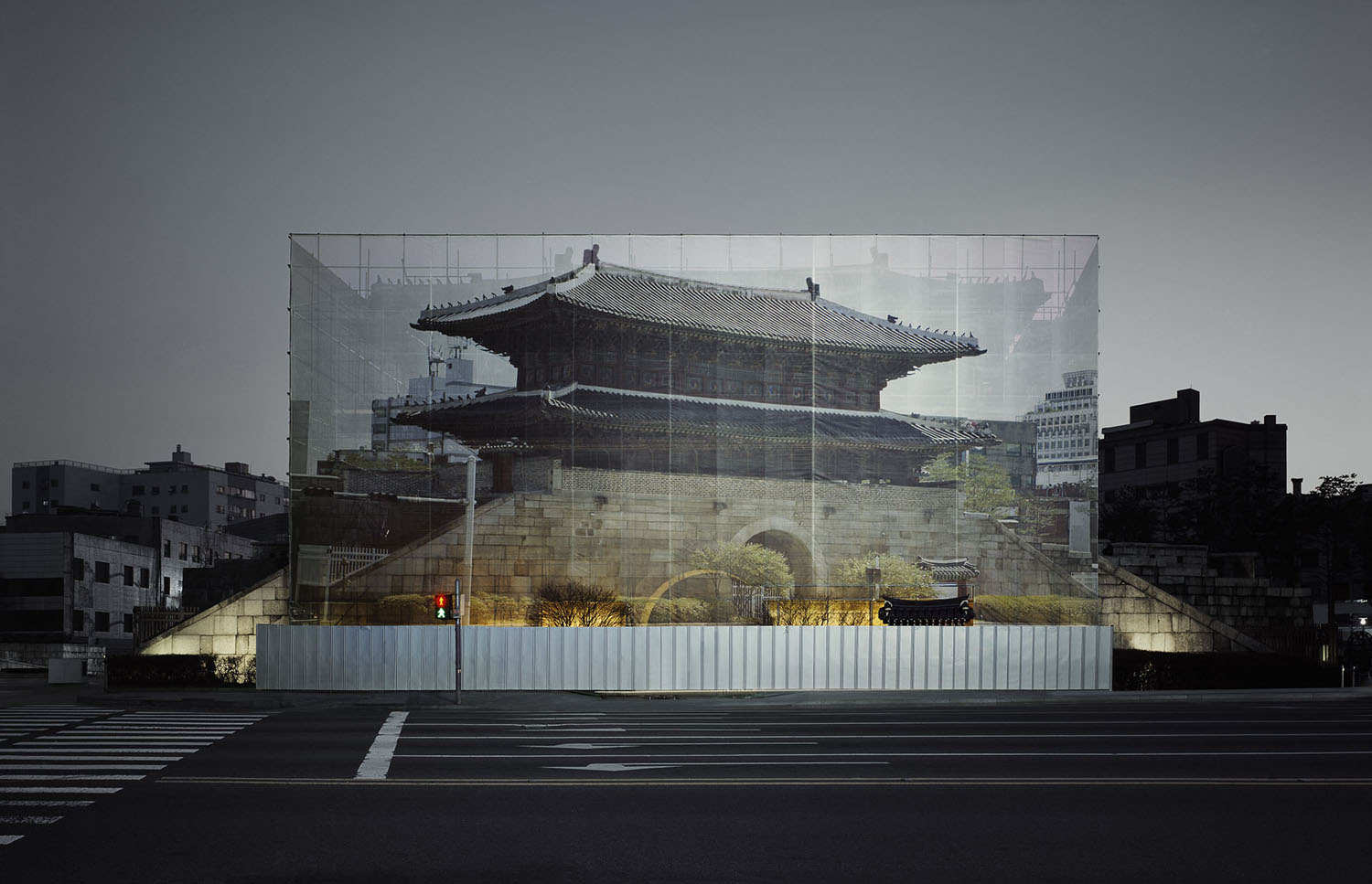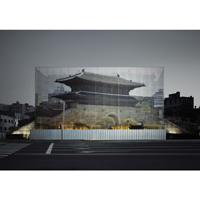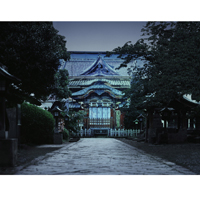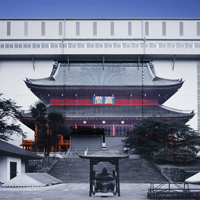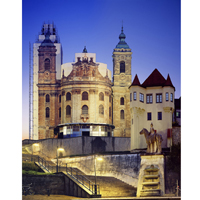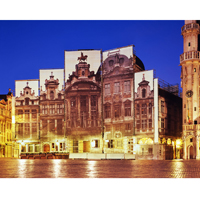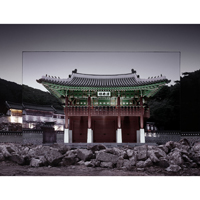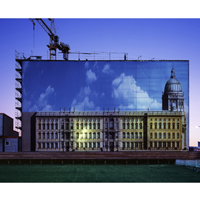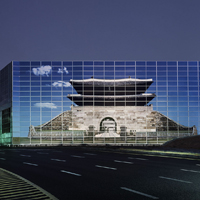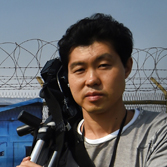
Han Sungpil, Savina Museum of Contemporary Art

Birth
1972, Seoul
Genre
Installation, Photography
Homepage
Exhilarating Magic of Images
Artist Han Sungpil, who has soaked in epistemological pleasure and illusionary effect from the confusion between reality (real) and reproduction (fake) through a series of 'Façade', now presents a new work 'In Between Layers'. A number of the ‘façades’ of buildings in his previous works can be divided into two types. First, a temporary façade that takes the place of the real façade in shabby condition by covering it during renovation work. Second, a permanent façade that becomes part of a building from the beginning. The former is fleeting and finite in that it will disappear when the construction is complete. At the same time, it plays as a mask that conceals the real appearance. Such a façade is an imitation that looks more real than the original as it not only resembles the real object but looks more time-worn. Meanwhile, the latter involves ‘graffiti’ work on the walls of monotonous and tedious buildings, which was given autonomy regardless of shape or structure. This can also function as public art. In this exhibition, the two types of façades are displayed.
Visual pleasure brought by his artwork is based on an intimate collusion between the real and the fake. 'The Counterfeiters' sketched by Maurice Henri, who once worked as a surrealist artist, offers an intriguing metaphor for such a relationship. In this drawing, the boss of counterfeiters yells, “what kind of a moron made the real coins?,” after examining the coins that were just produced. This episode tells funny truth about the relation between genuineness and counterfeit. The intent of counterfeiters is to pass counterfeit money off as genuine. However, the fate of counterfeit is preordained. It cannot be authentic even when it looks like a real coin and even when any great master works on it. In this regard, the master who creates a perfect counterfeit coin is regarded as a ‘fool.’ Is the counterfeiter really foolish? The purpose of this activity is to produce ‘genuine’-looking counterfeit currency. And the fool is the one who realizes his ideal.
Similar examples can be found in Korean traditional stories. Birds died by crashing into a painting of white cedar on the wall of Hwangryong Temple, drawn by an ancient painter Solgeo in the Shilla Kingdom. The work of the painter has its own purpose. In short, he tried to create a genuine-looking painting like counterfeiters. This apparently paid off. The perfect artwork fooled innocent birds and drove them into death. Only poor eyesight or optical illusion cannot be to blame for the confusion regarding whether it real or fake. Rather, the sophistication of the counterfeit or the painter’s ingenuity can be blamed for. There are excellent imitations that cannot be distinguished by ordinary people. Creating outstanding counterfeits is the principle of Mimetic arts.
In fact, the great counterfeiter, treated as the fool, is a victim of authority. His ability deserves praise if the criminal aspect of counterfeit is not considered. In other words, ethical criteria always intervene between the genuine and the fake. The former is good, while the latter is evil. This is based on a dichotomic principle or structure – genuine vs. fake, true vs. false, reality vs. reproduction, and original vs. copy. However, without counterfeit products, there could be no authority for the genuine article. The true can stand for its genuineness only when it is compared with the fake. And had it not been imitation, the value of the real object will be irrelevant. Meanwhile, imitation, reproduction and duplication provide pleasure when they replace the genuine article. How pleasure occurs through imitation is well demonstrated in Aristotle’s concept of public good. Let’s look into how this public good works in Han’s artwork.
First, the transitory façade. 'Laputa' shows a Gothic cathedral church with an arch structure and spires. The walls appear to be eroded and weathered marking the passage of time and the screen installed on the left wall is slightly protruded in symmetric position against the right wall. Above the screen that appears to be the real façade is a steel structure, indicating that construction is underway. The image on the screen must have been shot (a photo of the actual walls of the building) before the construction began. Compare the thick layer of dust on each brick with the real walls on the right side, then you will confirm this fact. All things considered, the photograph - an imitation - constitutes the building even though it is a finite installation on the left side.
The same goes for 'Plastic Surgery', which shows the image of the Namdaemun Gate, the first among the National Treasures of South Korea, with a combination of hundreds of photographs. This takes the place of Namdaemun that was burnt down and is currently under rehabilitation work, hiding the ugly appearance. Behind this grand cover is the gate under reconstruction. The purpose of reproduction is to overcome the limitations of existence: impossible to be present beyond time and space. For example, the portraits of a national leader in public places convert the space into a territory of reign. Meanwhile, the sacredness of a historic relic comes from its location. Like the cathedral in 'Laputa', we cannot move the location of the Namdaemun Gate. A replica of Namdamun, which was made of hundreds of pictures, owes its glory to the real object that has been there for hundreds of years. Although the cobalt blue sky looks strange and the combination of photographs keeps us from fixing our gaze steadily on the screen, the image holds the same impression of the historic Namdaemun Gate. 'Melting' also represents a temporary façade. The curtain draped in front of the building shows the distorted entrance, windows and balcony, which cannot function at all. As if the distorted image reflected on a mirror, we cannot open or close the windows, nor go out to the undulating balcony.
From the traditional perspective, which clearly divides the boundary between reality vs. fantasy and originality vs. reproduction, the latter represents a world deprived of essence. However, a reproduced image opens a world of autonomy. In fact, this is another complete world. As in 'Light of Magritte', reproduction does not stand for an incomplete world, subordinate to the real world, but another world made of images within the world. In this work, the painting “Empire of Light” of Rene Magritte was reproduced on a massive wall with curtains on both sides. The eerie image of the paradoxical combination of day (light) and night (darkness) cannot be existent in reality. So is the reality with this giant canvas. Lamps shedding light on the street and shadows cast on the ground symbolize darkness, while the clear sky taken as a long exposure indicates daytime. In this regard, “Empire of Light” becomes real through 'Light of Magritte'. The wrinkled curtains covering the painting on both sides show (or conceal) the landscape over the dark but dimly lit lake. In this way, the world of “Empire of Light” is unfolded between the curtains. The world beyond the curtains has a relationship with a world where the canvas exists. In short, the world, which is unfolded by ‘flinging open’ the walls of the building, is a metaphor for the world on the other side of the curtain.
Let’s look at other examples that ‘trompe-l'oeil,’ an art technique creating optical illusion, becomes part of construction. 'Back to the Future' illustrates an eccentric image beyond common sense. What is most remarkable is a horse-drawn carriage rushing out from between two buildings. A couple of white horses are galloping down the street while steam gushes out of a rear engine. The street lamp emitting light from the left building appears to be a long exposure. Thus, it is easy to recognize that the darting wagon is a painting on the wall, not a real object captured instantly. Meanwhile, the boundary between the real and virtual worlds is blurred in this delicate combination of present and past and of moment and perpetuality. The ladder placed vertically between the buildings must be a painting. What is the curved structure with the ladder? And what is the rear appearance of the building behind the structure? To what extent is the external wall of the left building (which is the backdrop of the carriage) real? One can experience visual pleasure from incomplete reality where a genuine-looking imitation (to the extent that it is hard to determine the boundary between the real and the fake), or the fake’s shameless assertion, cannot be overlooked.
This mechanism also works in 'Bon Marché'. It shows a market in a western town with people wearing traditional clothes, while a car is parked at the right end, which appears to be unbalanced. It is hard to find the border line of the giant canvas on which this scene is illustrated. However, it is clear that the space where the market is established, or the wooden construction, is located within the canvas. Given the dark right end and the artificial light illuminating the upper part of the left building, this scene must have been taken at midnight. But the marketplace is bright like the daytime. Therefore, the light may come from somewhere, from the lower part of the middle of the market where people are gathered. And stone buildings creating the sky line behind the wooden construction clearly function as a canvas. This fact is obvious because the flag with a word “1888” on it, at the rooftop of the wooden construction, overlaps with the wall of the rear building. In other words, the windows, fluttering curtains and plants climbing on the wall are all painted on the canvas. A child sitting on the street outside the wooden building is also part of the painting on the wall of the building at the back. The shadow cast over the building above the kid’s head indicates that the external wall plays as a canvas. Thus, the overlapped buildings create the shadow.
Likewise, 'The Wonderland Circus' is filled with mysteries. Using the rules of perspective in order to make space look three dimensional, windows are focused on the vanishing point in the right middle part of the building. A huge curtain is draped at the center as if it was hung on a fake wall and a clown in it looks like a crumbled paper because of the wrinkles from the curtain. Another painting within a painting and another frame within a frame are everywhere. Moreover, the windows in the left building serve as a frame. And yet, the canvas is only one and everything belongs to this mysterious fabricated world.
Images presented by the ‘trick the eye’ art can be divided into several categories by subject and theme. The first type transforms the flat plane into a three-dimensional space. Like painters who recognized the amazing effect of perspective in the early Renaissance period, in this type only the rules of perspective can be applied in describing space. Likewise, rectangles of various shapes fade out to the periphery of sight in 'Magical Watermill', as if they were drawn smaller in regular patterns under geometric principles. The space here becomes standardized and objects on the flat surface appear to be components in polar coordinates on the graph paper of a design plan.
Meanwhile, 'Paparazzi' makes you become oblivious to the effect of fantasy by including a story inside the frame. There is an arch corridor at front like Romanesque architecture and travelers are sitting and taking rest around the stairs. The red curtain on the wall and stained glass decorating the entrance adorn the building as a cultural heritage site. On the giant window at the top right, a church was painted as if it were reflected from the wall on the other side. A man with a backpack taking a picture, at the bottom right, plays a role in convincing people that the place is a real historic site. Therefore, the illusionary effect fades away as it becomes closer to ‘genuineness.’
On the other hand, the entire painting turns out to be genuine ‘trompe-l'oeil’ by maximizing its falsehood. In this case, illusion disappears in a sense because the gap with reality is so wide that its presence (reality of the painting) is not convincing any more. 'Swimming in the Sky' is such a case. The effect of illusion has vanished and only visual pleasure remains. On the gigantic wall, blue figures of diverse shapes were drawn and a woman with goggles in a rectangular shape is swimming idly in the water. In this regard, the wall plays as a huge pool. The blue backdrop above the wall is obviously the sky, but it gives an impression that the sky is linked with the blue background beneath it. But the enormous water drops hanging on the wall are grotesque, contributing to the falsification of the entire scene. The blue space within the wall, bordering with the sky, is not realistic, either. Is this space in the sky or water? Is the woman flying in the sky or swimming in the ocean? Where is the boundary of the sky and the water? These suspicions make this scene a preposterous fabrication.
Now the artist acts as a magician who opens up a world of images on the wall of a self-closed building as you can see in 'The Ivy Space'. On the ivy-covered wall of a brick building 'SPACE' is placed a large structure made of photographs of indoor space. This structure was designed by the artist to relieve a cramped feeling from walls and recover the original meaning of architecture: ‘space.’ Space is not supposed to be closed and two-dimensional, but the wall of 'SPACE' is closed. In order to overcome this limit of the self-contradictory building, the artist transformed the flat wall into a three-dimensional space by attaching pictures taken here and there in internal space. This way the building 'SPACE' becomes a transparent space. Although this is not technically a ‘physical’ space, thanks to the magic of analogy we can see a solid space on the flat surface. Over the clear window, the scenery on the other side is penetrated and the office, the study and stairs are seen.
Han Sungpil has persistently pursued the relationship of concepts that are closely associated with visual arts – resemblance vs. imitation, reproduction vs. reality, and fantasy vs. fiction. It is clear that unscientific elements, such as optical illusion, magic of reproduction and illusion of images, sustain these concepts. In this regard, art is not knowledge, nor science. His photographs once again pose a question about values in these ‘mysterious’ domains, well beyond knowledge. Our eyes are susceptible to optical illusion. The ‘trick’ has become more sophisticated in this exhibition. This clearly belongs in the domain of magic. Then should this optical illusion be cured? Plato once degraded images as a substandard form of recognition by considering that art is deprived of essence. However, people get a sensual thrill through this ‘deprivation’ and experience epistemological pleasure from this. In this respect, Han’s photographs successfully embody a pleasant structure of ‘trickery’ and ‘illusion’ that visual arts attract.
Park Pyeong-jong (Aesthetics, Photography Critic)
Han Sungpil’s Façades
“…pinned to the edges of vision”
quote from the song Magritte by John Cale
Han Sungpil’s Façades are mysterious arias. Last notes sung with a soothing timbre, before the sun comes up, before the action starts to tremble. He has chosen to study one universal subject in a limited amount of time; and one, which confronts our own perspectives with ambiguous details, similar to other bodies of his work, like “The Sea I Dreamt”.
In 2006 he encountered numerous cities throughout Europe and Korea in search of mega photo-realistic wrappings of construction sites and exterior architectura.
The photographic artist was first inspired to shoot façades after seeing the full scale covering of St- Paul’s Cathedral in London under renovation. The pictured canvas of the cathedral itself in dramatic lighting was so impressionable it turned more heads than the real church. What would the architect Sir Christopher Wren have thought if such impersonating canvases were around 350 years ago? (His officially approved design, called the “warrant design”, looked quite different to the reality of his work in progress, which he had already begun long before the plan was officially approved. Most likely if the faux façade canvas had been available in the late 17th century, the “warrant design” a sterner gothic design would have been the picture because it was the “official design”, thus possibly causing problems for the architect.)
From a photo-essay definition Han’s photographs of Façades are an image archive of a very common visual media … signs and banners…which have reinvented themselves throughout generations. In the 20th century alone the form of a public sign has undergone metamorphosis from plain word and image building advertisements, to the Billboards along motorways for the car driven society, to oversize film Banners(Bollywood), to the Godzilla LCD’s displays strategically placed amongst Cityscapes.
Han Sungpil’s picture perfect objects though are closer relations to theater stage sets or movie sets even though they are rooted in the advertising genre.
The subjects offer the view, usually one to one in scale of what the future could be. His subject highlights the promise of change for the better and not the confusion of urban renewal or the slow and dirty work in progress. Often the future is constructed as perfected reminiscent from the past as seen in the photograph made Munich, August 2006.
Han has painstakingly worked at capturing his subjects during the mysterious lighting before the break of dawn. Although important photographers such as Walker Evans, Gabrielle Basilico or Thomas Struth have set more architectural documentary precedents for Han to remark upon, it is René Magritte who is closer in spirit. The Belgium surrealist painter’s “the Empire of Light” is a perfect example: a house surrounded by black woods has a crown of light blue sky and a sepulcher in the form of a glowing street lamp. Han’s Façade images are quiet, not over lit, sometimes at first appear too dark, but clinging to an intrinsic energy. Simply said, vampiric.
Through his photographs the given elements of optical illusion appear dissected and recomposed, resulting in something exponential.
The long exposures compress the transition of place, time and light to give us the still image of what hangs on the wall. They comprise an illusion, a dream, which the photographer himself does not see but thinks through and absorbs on his film: a summary of waiting, breathing, pondering and risking. It is the result of recording his own moments of decision and his next destination.
Celina Lunsford (Artistic Director, Fotografie Forum International)
The Flâneur's Poetic Tricks - Notes on Han Sungpil's Photography
I start on a personal note: I knew Han Sungpil first as a photography artist, long before he created video and installation works. And I think he will always be a photography artist, despite different kind of issues he has worked on, even when he does not work with a photo camera. This is quite obvious in the different kind of works he has created so far, which I think have been developed from the logic, tradition and discourse of photography.
One of Han's artistic manners, I am most familiar with, is his constant need to travel to distant places, just to take pictures. In 2004, for example, when I hosted him as a resident artist at SelasarSunaryo Art Space, Bandung, he had just finished traveling and photographing in the Sahara Desert. During his residency in Indonesia, instead of just living and working in Bandung, or Java, he chose to visit a remote inland area in Kalimantan to take pictures. From his travel to this remote area, he produced a series titled 'Blue Jungle(2004 - 2005)', which portrays a forest situation in Pangkalan Bun, Central Kalimantan. This photo series dramatically portrays miserable tree logs and stumps, the remnants of illegal logging and fires. Upon his return from Indonesia, Han continued his adventures to photograph, traveling to Ireland, France, Germany, USA and so on. Up to today, he has shot at more than one hundred sites in many different countries around the world.
Over the past decade, Han has gained a lot of experience crossing geographical and cultural borders. He had many face-encounters with strangers, hang-out with them and worked with new people, often in different and unexpected situations. Indeed, ever since the development of the handheld portable camera, the practice of 'a photographer as flâneur' is not a new discourse. However, as in the case of Han, the experience of traveling and the technical mastery of the camera is not sufficient for an artist. Having known him for a long time now, I think Han has a particular flexibility in adapting to new environments. Through the experience of his great many extensive travels, he can grasp things fast and he can easily go back-and-forth between everything 'foreign' and 'intimate' in different spatial contexts. All this, in turn, has helped him conceive ideas for his work.
Objects that Han is interested to photograph are quite often icons or identity markers of a location. But far from merely capturing exoticism, Han's works are mostly produced through fieldwork, observation and detailed study of objects in the locations. He is never fascinated solely with what looks new and unfamiliar. He uses his camera as a device to produce something that provokes an unexpected perception.
At least during the period 1998-2005, many of Han's works highlight a poetic nuance, as seen in the series 'My Sea,' 'Blue Jungle,' and 'Ground Cloud.' Han captured natural scenes and landscapes with large format cameras using long exposures, which led to enigmatic and theatrical effects. The sea and the beach are mostly covered in fog, shrouded in mystery; the trunks and stumps are not branched, leafless, lonely in the middle of nowhere, overwhelmed with grief; clouds are portrayed as if they are dancing on a single vortex. It is not a certainty of meaning or information that is conveyed by these photographs. Providing an inducement to the world of imagination, they, instead, persuade us to look with an intensity of emotion.
The 'Façade' series(2004-present), however, can be regarded as a conceptual leap in Han's artistic journey. The main objects in these works are mostly exteriors of various buildings that connote an architectural splendor and a Zeitgiest: Gothic cathedrals, hotels, office buildings, art museums, historic old forts, etc. Han composes the objects in such a way that they may remind us of the blocking strategy in the staging of a theater performance, where the contrast of lighting, placement of the main objects and background are carefully orchestrated to produce a dramatic effect. On the facades of the urban buildings we can see some misplaced imageries – some are phantasmatic and illusory – for example: A vague part of the building itself, rural landscapes, giant birds, or buildings from another time or place.
Han's Façade series began when the artist started to document reconstruction on and restoration of buildings or sites in various urban environments in Europe and Asia. Initially Han was interested in the veil or banner used to cover the actual building and development process, as they often do it with gigantic photographic images. To him, it resembles the practice of photo collage or the manipulation of an image. While continuing to research and photograph, Han also developed his own ideas about creating illusion through photographic images. In 2007, instead of just documenting the urban landscape, he began the project by creating his own giant banner that shows the image of a building’s facade. He constructed the banner in front of the actual building, and then photographed it. It resulted not only in an actual optical illusion in public space, but it also resulted in a manipulation and intervention through the presence of a 'false' reconstruction project.
In the following years, the direction of the Façade project gradually became more conceptual. It alludes to an awareness of the relationship between photography and a broader history of visual culture. Han traced back the historical link between the 'veil' that envelope the building's facade and the traditional trompe-l'©«il paintings, which provide the illusion of a three-dimensional image on a two-dimensional plane. It kindled his growing curiosity, which finally persuaded him to apply to a number of residency programs in overseas (France, 2008; Germany, 2010; and USA, 2010) and continue his research for this project.
Han's artistic investigation resembles a phase when a photo connoisseur is dragged into a certain point of interest. Roland Barthes calls this a punctum, which occurs when a particular appearance in the photo leaves a deep imprint in the viewer's interpretation. Han's interest in the urban facade and trompe-l'©«il started on a visual and perceptual level. But the project has gradually moved towards a philosophical inquiry. Critic Park Pyeong-Jong offers an interesting analysis, he says that the Façade project in fact questions inter-related binary oppositions all at once, namely 'resemblance versus imitation', 'reproduction versus reality', and 'fantasy versus fiction'.
Another binary opposition that could be added here is ‘real versus fake’, which is linked to the nature and identity of the main medium used in Han's project, namely photography. Throughout the 20th century, photography experienced a process of naturalization. It was considered the medium that delivers the exact representation of reality through the power of mass media and information industries, which use photography to express verism and truth. In recent years, however, this premise has changed. Photography has gradually become a medium that prompts questions rather than answers. With the advance of digital technology and the ever increasing private use of camera and computer, today a photo image could easily raise the typical question: Is it real?
Although 'tricks of the eye' can also easily be found in the practice of analogue photography, the fact is that a digitally generated photo tends to be more questioned than trusted. This may also be connected to the epistemological basis that coexisted with the development of photography. Historically, the claims that validate the analogue photography as a medium that can come closest to reality emerged from the spirit of the 18th century Enlightenment, which upholds universality, truth and certainty, especially through science and positivism. While the development of digital photography at the end of the 20th century was closely related to the relativity and uncertainty emphesized by postmodernism. Postmodern discourse on photography emerged with a growing interest in semiotics and French post-structuralists' concepts, such as 'the death of the author', 'simulacrum', 'deconstruction' and so on, which have lead to critical questions on the myth of 'the real' and 'originality'.
In the discourse on digital photography, terms such as 'manipulation', 'editing' and 'engineering' can sometimes be equally deceptive, depending on the purpose and context of the photo, and how it is read. We can always question whether the photographs that Han has produced for the project are 'original' or 'digitally manipulated'. But it is no less important for us to know why we, the viewers, are always so concerned about originality and authenticity. Which one is more important: originality of the photo, or the ultimate impact of the image when we see it? Philosophically, the binary distinction between 'the real versus reproduction' could be seen as an idea burdened by a certain logocentrism. It is the power of empirical and scientific knowledge that has made the former term more dominant than the latter.
The link that Han has made between trompe-l'©«il paintings and the photographic facade could lead to another discussion on the 'real' and 'illusion'. The history of trompe-l'©«ilis associated with the concept of illusion that was created to achieve an impression that is close to a surrounding environment. Traditionally it was done by presenting a three-dimensional space, building, landscape, or natural objects, as an analogon to reality. Some paintings built the illusion through a precision of detail, appearance, lighting, perspective and color palettes. Trompe-l'©«il can be seen as the early predecessor of virtual reality (VR) technology, which is an advanced 21st century technology to realize ideals and fantasies digitally. From both trompe-l'©«il and the VR technology, we learn that the human obsession toward illusion is rooted deep in our human history. The production of illusions seems to reflect an a perpetual need to run away from reality. Typical in any trompe-l'©«il is that visual tricks or manipulations can always be easily recognizable. However, even when observers can recognize it as an illusion, often in a matter of seconds, they still enjoy it.
In Han's Façade, one of the the interesting parts is when the giant banner or the trompe-l'©«il is purposely stressed and exposed, so that it is presented as an illusion or imitation in the real world. At hindsight, we see buildings and an urban landscape that are completely awkward, because such 'an analog manipulation' actually emphasizes the presence of the manipulation or trick. When we no longer question how false the banner is, we may have known that we were being ripped off. Being ignorant, we can also treat manipulation as something normal and never question the presence of other eye tricks in our everyday reality. We can always enjoy a 'hoax' as an aesthetic pleasure. This condition may represent a 21st century ‘visual turn’ in which our perception of reality and truth has shifted. Han's project has made us aware how our curiosity about 'the real' is as perpetual as our ignorance of 'the fake'. In between the two poles of the 'real' and 'fake', it turns out, there are some more layers, which makes the distance between the poles less oppositional.
Another project of Han, 'Memories and Traces', still deals with the artist's observations and study of architecture, landscapes and urban situations. Some works in this series shows views of remnants of a demolished building, which looks like as if it is sliced by a giant super sharp knife. It is interesting to see this series exhibited in juxtaposition with the 'Façade.' While the Façade series shows the exterior and false facade of the building, 'Memories and Traces' actually shows the interior part of the building, as if the inside part represents the true reality. Here, we can recognize Han's skills to compose all the visual elements in the photo to become a poetic expression. Here I imagine the Han Sungpil I know: an artist, photographer, adventurer and flâneur', who keeps on wandering, but not without purpose. He may never overly be burdened by any obligation or sense of urgency to be a critic or social commentator, because he still feels compelled to enjoy photographing as an artistic pleasure. Han's photo works represent narratives, through which we not only gain an understanding of the world, but also a kind of reminder of how we understand the world through photography.
AgungHujatnikajennong (Lecturer at Visual Art Study Program, Faculty of Art and Design, Bandung Institute of Technology, Indonesia)
The Aesthetics of the Sublime
What is it about the barren environment of the Polar Regions that fascinates us? In the 18th century, Edmund Burke gave a classic explanationon the sublime, that it is an overwhelming object that rouses pain and fear. He saw the sublime as an ambivalent emotion: when we are overcome by something colossal we feel an anxiety that entails joy. Then what is the identity of this happiness hidden in horror? Immanuel Kant explains it as an extension of existence: we first undergo fear when we see something beyond our normal scale of perception, but during the psychological processing of the phobia, we are taken to a sphere of infinity, beyond our sensual limitations, and it is that moment when we reach a state of 'delight', incomparable to that of any pleasure.
What provoked Han Sungpil to the Polar Regions may have been such emotion of sublimity. His photography with respect to the areas reminds me of Caspar David Friedrich’s 'The Sea of Ice'. The painting depicts a shipwreck and chunks of Arctic ice piled on top of it, as if a white mouth of Mother Nature has sardonically swallowed a ridiculous human trial. However, from man’s perspective, nature is no longer in the domain of the sublime. It was until early 19th century, being a horrific force impossible for mankind to overthrow. Meanwhile in the present, it rather needs protection from the tyranny of the avaricious modern man with an arsenal of technology. The Polar Regions are no exception of this deprivation of conventional sublimity. It has been a while since the practice of human exploitation has been exercised in even the most remote areas over and around the two poles, places where nowadays paying a call has become a comparatively affordable tourism program for a considerable population.
Meanwhile, the sublime in the contemporary is rather the vast series of human breakthroughs. What blows us away today is not the works of nature, but those of the cutting edge, and a global capitalism that nullifies the control of individual states. The photography of Andreas Gursky, including the exquisite example of his 'Chicago, Board of Trade II', well depicts the technological sublime in the digital era. Conversely, what we see in the works of Han is a return to the natural sublime. However, why now, in the time of the technological sublime? Strictly speaking, there is nothing new about photographing the presence of the polar. All one has to do is pick up a copy of National Geographic. Better yet, going to an IMAX theater and watching a movie whose setting is the Polar Regions can be an even more vivid experience.
Recalling the natural sublime to the present entails the risk of descending down to a visual cliché. However, in the works of Han, there seems to be the intention of recovering the dignity of nature, a nature that has been undergoing the visual exploitation of man’s intellectual curiosity. It is as if the works are trying to tell us that no matter how great our avarice is, how great our technology is, we are after all finite beings, destined to one day being buried in the even greater arms of Mother Nature, like the ship in Friedrich’s painting.
The sublimity Han experienced during his visit in the polar world is related more to time than space. His work depicts the flow of time preserved frozen in snow and ice. The stratification of snow shows the many years that have flowed over the strata. It is here where Han witnesses the frozen infiniteness of time. Despite our spatial conquest of the Arctic and Antarctic, we are still incomparably trivial beings when we go face to face with the capacity of their time kept in ice. With respect to this observationof polar time, Han told me quite an interesting story. When the people there drink whisky on the rocks, the ice being small chunks from the glaciers, they say small bubbles of air come out from the ice. The older the ice, the more bubbles ascend. They say this proportional relation it is due to the fact that older ice has been compressed by the weight of a greater time, hence contains more air. What can better show how polar glaciers are possessors of perpetuity?
Other extensions of Han’s perspective gaze at the abandoned facilities and equipment of exploitation man built and abandoned. Although it has not been too long since their builders and operators left them, the newest stratum of snow has already grown on top of them. Hal Foster may call this the “fixed-explosive”: one of the uncanny effects surrealists sought, for instance the psychological impact that is generated by the image of a fast-moving object suddenly halting or that of the collapse of civilization. A frozen image of a turning ballerina or a picture of a locomotive entrapped in a shrubbery. It were photographs of this kind that captivated surrealists. If one desires to comprehend this charm, recalling the feeling that comes from observing Ta Phrom buried under the roots of the gigantic trees growing out of the old temple might serve them well. The photographic representation of human traces buried in snow and ice saturates its appreciator with a similar emotion. In the setting of the polar uncanny, there lies the impulse of death. For me, Han’s polar photography is a stroke of 'memento mori'.
Chin Jungkwon(Professor of Dongyang University)
Façade project
The screen hiding the field of repair work is reborn again as a vast painting. It belonged to the world of entirely ‘things’ for obvious practical design in the past. It is the object shielding the disorderly field of construction work from public gaze. But when we put image on the screen, the layer of meaning is placed on the material predicate and the object enters into the virtual world projecting optical illusion. A façade becomes not a thing but media and attempts to make itself understood by the masses walking along the street. May it be a kind of public art which comes from the development of the large-sized printing technique?
The virtual façade is an ephemeral mask. It fills the absence of something temporarily and shall be removed not only from the world of things but also from the virtual world after construction. When a screen is removed, the image on it cannot but vanish. As the performances and the installation leaves a trace as materials afterwards, so the virtual façade is guaranteed for perpetuity only by means of photograph. Han Sungpil saves the ephemerality of virtuality aesthetically. While Eugene Atget delivered the obsolete structures of Paris, Han Sungpil saved not the building itself but the mask wrapping a building briefly. He acknowledges the superficiality of shell.
In a sense, Han Sungpil’s work seems to be typological. But rather the far awayness like an atmosphere in a landscape than taxonomic cold-heartedness of record is felt in the image immersed in the dusk. The superficiality of the copy combined with the original aura strangely at this point. The atmosphere comes from the intentional blending of the real light at dawn and dusk and the false light, that is, artificial illumination. It is a so called ‘media façade’ that we watch from his work. But neither large LED screen nor new media illuminating by itself but an archaic old media, namely picture and photograph was used in his work. Because photograph and picture can not give out light by itself, his façade is capable of having an atmosphere in the dusk of blending natural and artificial light.
It is not his primary concerns to save the disappearing thing through the record of photograph though. His eyes are on the other concerns. Han Sungpil has representation as his subject by duplicating a duplicate. To duplicate the duplicate blurs the distinctions between the actual and virtual object. Reality and virtuality hold the same virtual position on the printing paper. Thus, actual building is hardly distinguished from virtual image in his some works. Though reality and virtuality can be discerned, the virtuality in the work has an atmosphere more than real object hided by the image. As the natural and artificial light is mixed up without borders, so virtuality and reality get entangled on his picture without borders.
A virtual façade has the strange doubleness ontologically. It is the picture existed on that spot and at the same time it is the picture which will exist there. It is not only a duplicate of precedently existed original but also the archetype of subsequently existing building. In a word, it is the duplicate of the past and the plan of the future. As Janus who looks in opposite directions, it restores the past and represents it and unfolds the future. Here comes from the interesting game of the meaning. The viewfinder is an experimental exploring tool which the photographic artist cast the images toward the future. In the aspects of planning the future, the virtual façade is also a kind of viewfinder. Han Sungpil has ‘photography’ as his subject consequently by placing the viewfinder of building on the viewfinder of the photograph again. He not only duplicates a duplicate toward the past and also plans the plan toward the future concurrently.
There is neither duplicate nor plan among Han’s picture of facades. For example, it is a using trompe-l’eoil. At this point, the virtual façade does not replace the absence of already existed but create a completely new fantasy world which neither exists and nor will exist there afterward. The visionary virtuality will be comparatively clearly recognized by the observer passing on the street in the actual life. But when it will be duplicated as a photograph again, the boundary of virtuality and reality is blurred and the image in the picture becomes a kind of virtual reality.
Why does the virtual façade appear? There may be some reasons. Firstly, Dada, pop art, public art and installation provide a condition that daily thing like screen can be considered as the public installation for the masses. The experience of watching the virtual image on the wall of building unexpectedly is the daily life in this era that the flood of the image flow over the large screen set up on the building. Furthermore, today is the era that the boundary of original and duplicate is blurred, virtuality and reality are mixed up, and the lineage of time collapses and the representation becomes the plan concurrently, isn’t it?
In this way, technical condition, cultural memory and the transformation of world and human being are condensed in the virtual façade recently appeared on the street. The reason why the Han Sungpil pays attention to the façades is he smelled the very scent. The ‘façade project’ reminds me of Walter Benjamin’s Passengen(Arcade)-Werk. As Benjamin read the 20th century in the Arcade of Paris in the Thirties, isn’t it possible for us to encode the dream of 21th century in Han’s 'façade project'?
Chin Jungkwon(Aesthetics, Adjunct professor of Chung-Ang University)






